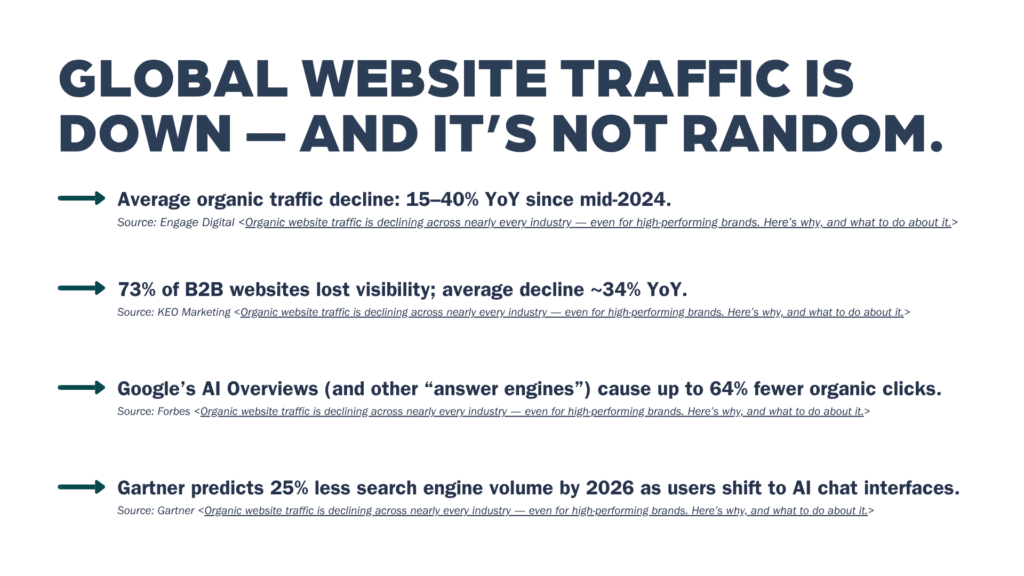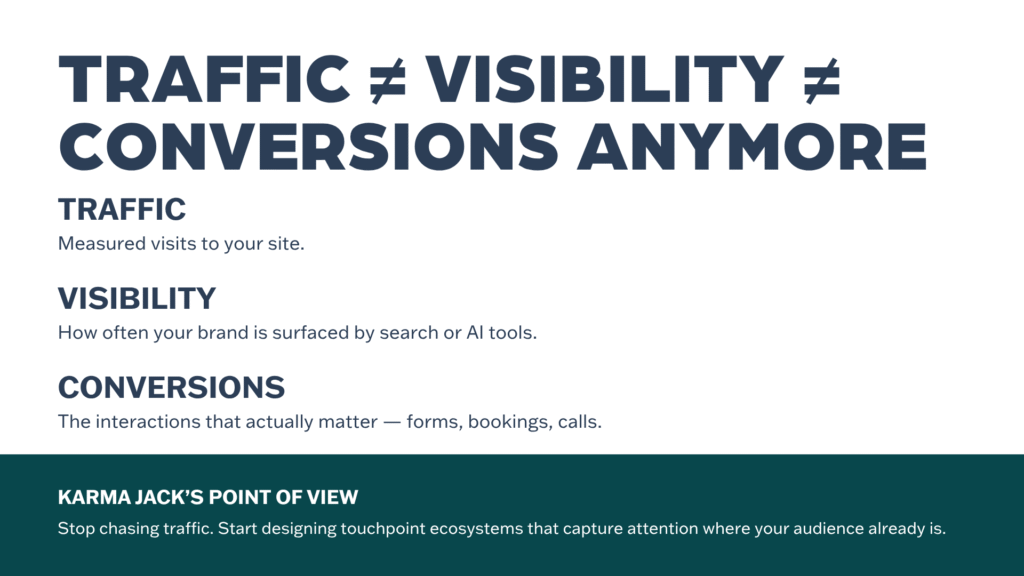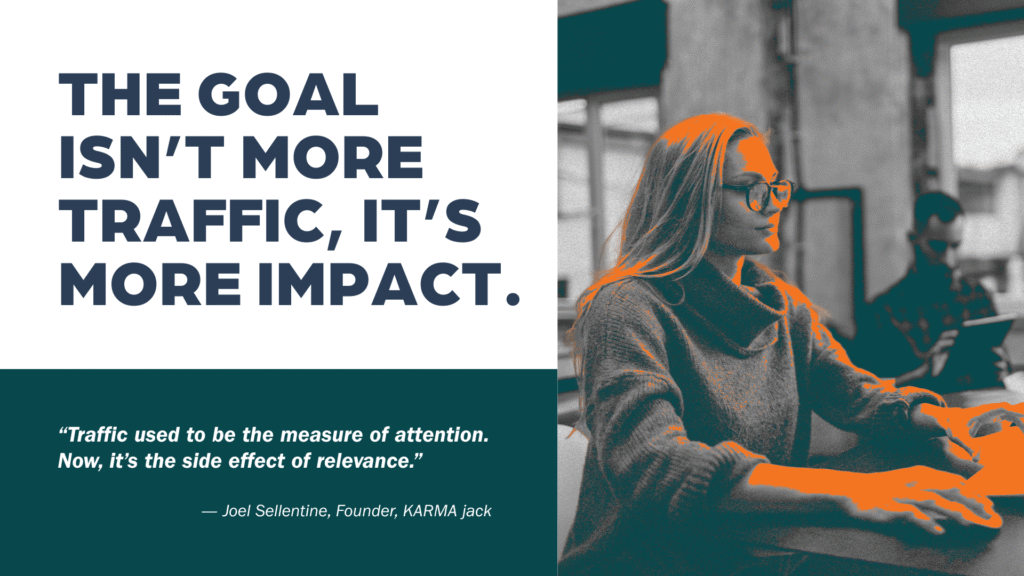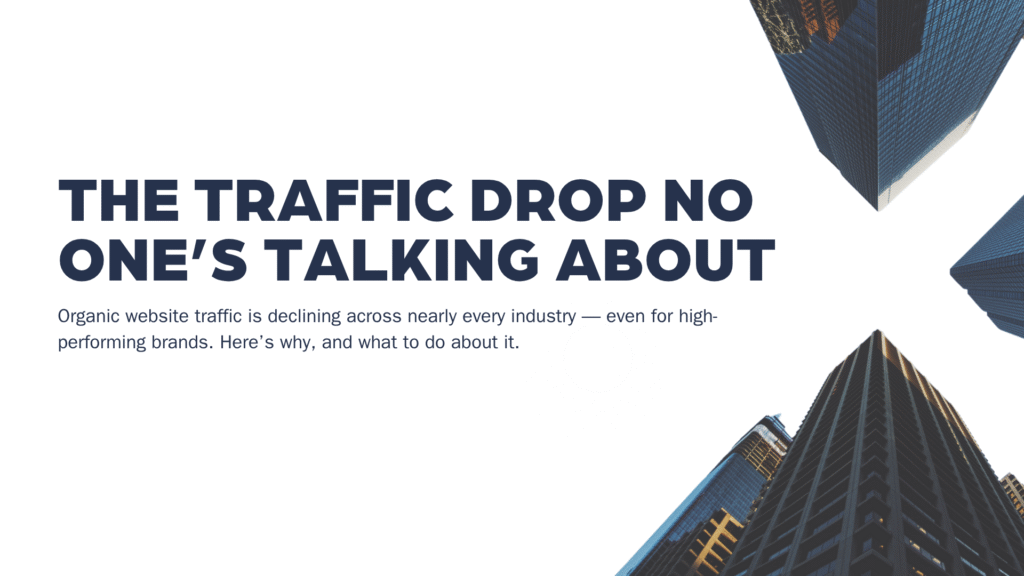“Traffic used to be the measure of attention. Now, it’s the side-effect of relevance.”
1. The Landscape Shift
For years, organic website traffic was the dependable foundation of digital growth. You optimized for keywords, built backlinks, published content — and traffic increased (or at least you hoped it did). But now, we’re in the middle of a systemic shift: traffic (especially organic search traffic) is dropping, and if your strategy hasn’t adapted, you’re going to feel it.

Here’s what the data is showing:
- According to the analysis published by Forbes, the rise of AI-powered search and answer engines (like ChatGPT, Perplexity and Google SGE) is correlated with organic traffic declines of 15–64% depending on industry and query type. Forbes
- A study by Search Engine Journal found that click-through rates (CTR) for the top organic result dropped from ~28% to ~19% post-AI “overview” rollout. Search Engine Journal
- On the informational side (queries like “what is…”, “how to…”), nearly all of them are being triggered by AI-generated answer boxes rather than the traditional result list. Higher Visibility
- A notable real‐world data point: The Wikimedia Foundation (owner/operator of Wikipedia) reported a drop in human page-views of ~8% attributed to AI/search changes. Search Engine Journal
Bottom line: The old assumption — “if I rank #1, I’ll secure predictable organic traffic” — is no longer valid. We’re moving into what I’d call the post-traffic-volume era.
2. Why It’s Happening (and What Changed)
Let’s unpack the structural factors behind this shift — and importantly, address what you can control.

a) Search engines have become answer engines
Rather than giving users 10 blue links and expecting them to click through, search providers now serve answers directly — through AI summaries, chat-bots, rich snippets, and “zero-click” SERPs (search engine results pages). This means the user often finds the answer without ever visiting a website. Wikipedia
b) AI Overviews / Generative features are gaining priority
Google’s “AI Overviews” (and comparable features by other platforms) are being triggered more and more. For example:
- In one study, informational queries triggered these overviews in ~99.2% of cases. Higher Visibility
- Another study found first-position CTR dropped significantly when these overviews appeared. Search Engine Land
c) Discovery behavior & device context are changing
Users are more likely to ask voice assistants, mobile devices or AI-chat interfaces. The friction of “click a link → load page → read” is greater than “ask a chatbot → get answer”. Additionally, many answers now live on the SERP itself, reducing click-through opportunities.
d) Traffic volumes are being redistributed
It’s not always that overall search volume is down. Rather:
- Some users never click a link (zero-click).
- Some queries stop being routed through old “organic” channels.
- Other touchpoints — social, voice, local, AI-agent referrals — are growing.
In other words, the game isn’t over. But the rules have changed.
3. What This Means for Brands and Agencies
For you at KARMA jack (and for your clients) this shift demands a recalibration of both mindset and metrics. Here’s how to view it:

Focus shifts: From “traffic” to “touchpoints”
Traffic used to equal opportunity. Now it’s one of several, and often a less reliable one. Your emphasis should be on meaningful interactions (calls, chats, bookings) rather than just pageviews.
Visibility ≠ Clicks
Ranking high is still useful — but if users aren’t clicking, then ranking alone doesn’t equate ROI. Look for engagement per visit instead of visits alone.
The bar for “discovery” has gone higher
To be part of those answer-engines, your content must be structured, authoritative, easily digestible by machines — not just humans. Brands that adapt will win the next decade; those that rely on legacy SEO will struggle.
Local, brand-intent, and “high-intent” queries are more resilient
While informational traffic is dropping fastest, transactional and local queries (e.g., “red light therapy Royal Oak”) remain more stable. That means:
- Emphasize local optimization and “near me” search.
- Build brand authority so when your audience does click, it converts.
- Integrate other channels (paid, social, events) as discovery paths, not just organic search.
4. A New Playbook for 2025 and Beyond
Here’s the strategic framework I recommend for KARMA jack and its clients in this evolving search ecosystem:

1. Optimize for AI-Visibility (yes, that’s a thing: GEO)
The rising discipline of Generative Engine Optimization (GEO) focuses on how to get content cited by AI engines, not just ranked by Google. arXiv
Actions:
- Use schema markup, structured FAQs, conversational language.
- Build content that is “AI-friendly” (clear definitions, authoritative tone, richly referenced).
- Monitor for “answer-box” placement and discoverability by chat/assistant platforms.
2. Content clusters > isolated pages
Rather than sporadically publishing blog posts, build semantic topic clusters around core services (e.g., “red light therapy”, “hyperbaric chamber benefits”, “DEXA+ overview”). Each cluster contains: overview page + FAQs + case studies + local landing pages. This structure helps both human users and machine algorithms understand relevance and depth.
3. Diversify traffic & funnel sources
Organic search is still part of the mix — but not the whole mix. Add:
- Paid search (to guarantee visibility)
- Local listings + voice search optimization
- Direct engagement (events like the Oakland race, QR capture, AI-bots)
- Social/short-form video (TikTok, Reels) as discovery channels.
4. Re-define metrics of success
Ditch the singular focus on “sessions” or “visits”. Instead measure:
- Leads per interaction (chat, call, form)
- Conversion rate by source (AI-chatbot leads vs. website leads)
- Engagement depth (time on site, pages per session, returning visitors)
- Cost per acquisition (CPA) in this new environment
5. Lean in on brand, trust & local relevance
As AI engines increasingly favour authoritative, trusted sources, your brand must build and broadcast credibility:
- Reviews, testimonials, case studies
- Local relevance (multiple clinic locations, optimized for “near me”)
- Mobile/UX excellence (fast loading, clear CTAs, user-friendly)
- Thought leadership (blog, webinars) as part of “expertise” signals
5. What I’m Watching (and You Should Be Too)

- Growth of zero-click searches. Analysts estimate up to 60% of queries may result in no click. Forbes
- Increase in voice/assistant-based search (e.g., prompts to ChatGPT, voice search via mobile).
- Search engine rules for citations: Which domains are being referenced by AI? What content types pop up in the “answer” boxes?
- Local search dynamics: As discovery shifts away from broad queries, local relevancy and the “near me” mindset become stronger.
- Monetization and business models: As web traffic becomes less reliable, brands may lean more on direct relationships (email lists, memberships, events) rather than solely ad‐driven traffic.
6. Final Thoughts

At KARMA jack, our mission has always been to simplify complex systems, deliver measurable results and stay ahead of change. What I believe today is not just that traffic is dropping — but that the nature of discovery is changing. And that’s good news if you act decisively.
What to do next:
- Audit your client’s top performing pages: Are they still getting clicks? Are they getting qualified clicks?
- Identify where your best leads are coming from (and perhaps where they aren’t) — shift spend and effort accordingly.
- Invest in strategic content clusters and AI-readiness now, so you’re not caught reacting when the next jump arrives.
As Simon Sinek says: “People don’t buy what you do; they buy why you do it.”
In the new search landscape, you don’t just want your website to show up — you want your brand to be the answer.
Let’s build that future.
References (for further reading):
- “The 60 % Problem — How AI Search Is Draining Your Traffic” (Forbes) — https://www.forbes.com/sites/torconstantino/2025/04/14/the-60-problem—how-ai-search-is-draining-your-traffic/ Forbes
- “Why Organic Search Traffic Is Dropping Fast in 2025” (EngageDigital) — https://engagedigitalinc.com/blog/why-organic-search-traffic-is-dropping-fast-in-2025/ engagedigitalinc.com
- “Google CTRs Drop 32% For Top Result After AI Overview Rollout” (Search Engine Journal) — https://www.searchenginejournal.com/google-ctrs-drop-32-for-top-result-after-ai-overview-rollout/551730/ Search Engine Journal
- “Why is Organic Traffic Decreasing? Reasons & How to Fix” (HigherVisibility) — https://www.highervisibility.com/seo/learn/reasons-organic-traffic-dropping/ highervisibility.com
- “The Decline of Organic Traffic and the Rise of AI: Inevitable Shift or SEO Crisis?” (MarTech Magazine / Liminal) — https://liminal.pt/martech-magazine/en/the-decline-of-organic-traffic-and-the-rise-of-ai-inevitable-shift-or-seo-crisis/ liminal.pt
AI Summary & Key Takeaways
- Organic traffic is declining due to the rise of AI search traffic, with studies showing drops of 15-64% across various industries.
- Search engines now serve direct answers instead of traditional search results, which reduces click-through rates.
- Brands must shift focus from traffic to meaningful interactions and engage in Generative Engine Optimization (GEO).
- Local and high-intent queries are more resilient, so brands should emphasize local optimization and build authority.
- To succeed in the evolving landscape, brands should diversify traffic sources and redefine success metrics beyond traditional visits.
Estimated reading time: 8 minutes


